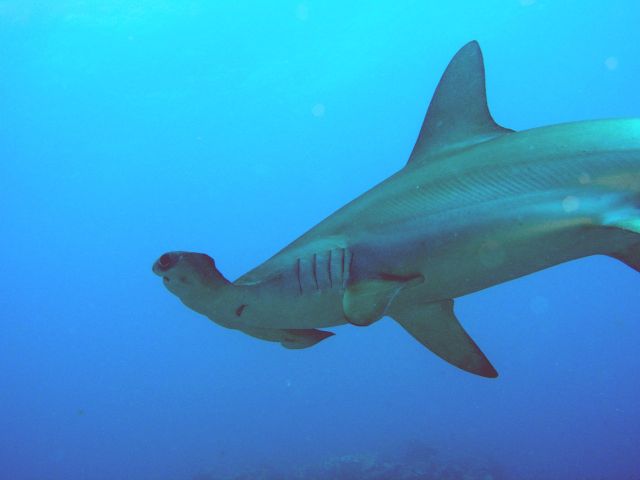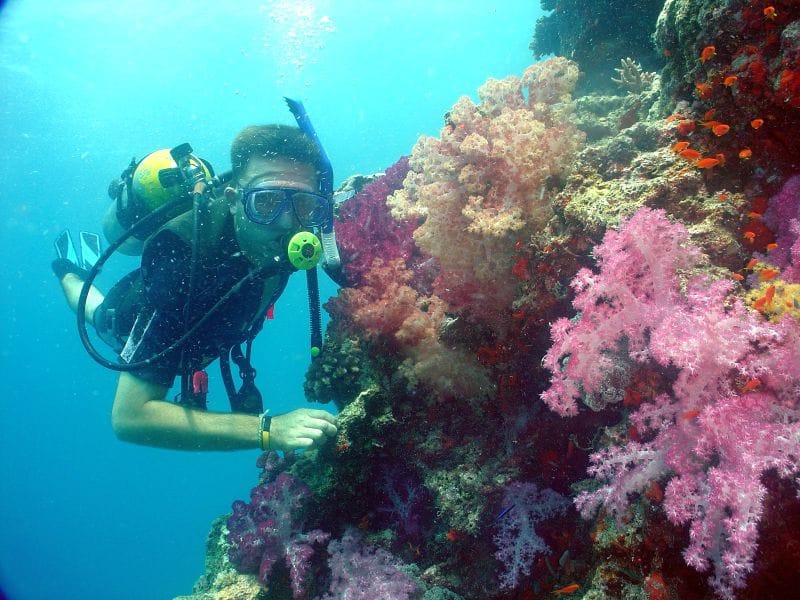The beautiful islands of Fiji are a true paradise for vacationers, especially snorkelers and scuba divers. With their magnificent and world-famous soft corals, incredible seascapes, and hundreds of critters, Fiji’s dive sites are sure to please every diver and make everyone excited and truly satisfied. Over the years it has become very popular with several dive operators offering underwater shark feeding during which avid scuba divers get to see many and large sharks up close.
Types of sharks in Fiji
There are well over 400 species of sharks in the world’s oceans. The waters around the Fiji Islands, with their diverse coral reefs, are home to about a dozen species of sharks. The most common shark species found on coral reefs are the white-tip reef shark, blacktip reef shark, and grey reef shark. Other types of sharks that can be found on the coral reefs with a lot of luck are nurse sharks, lemon sharks, leopard sharks, scalloped hammerhead sharks. These shark species prefer to stay in a comparatively small territory.
Other shark species that patrol a much larger territory of several hundred square kilometers of ocean and only occasionally seen on reefs are bull shark, silvertip shark, tiger shark, great hammerhead shark.
But those are not all types of sharks that may be seen in the ocean around the Fiji Islands. There are oceanic sharks that are rarely seen in coastal waters or strange swellsharks that live at great depths and even whale sharks may occasionally swim through Fiji’s waters.

Shark Feeding in Fiji
Quite a few divers visit the islands to go Shark diving in Fiji. The shark dive south of the main island of Viti Levu is one of the most famous shark-feeding dives in the world. Sharks are fed here several times a week, there is no cage, divers just sit a couple of feet away on a ridge, while the guides in the “arena” hand out chunks of fish.
The abundant presence of bull sharks, tiger sharks, nurse sharks, white tips, silvertip, and grey reef sharks makes it a heaven for shark divers, and this is one of the reasons why the archipelago of Fiji is on many divers’ bucket list.
While several countries in the world have banned, in recent years, shark feeding for several reasons, most of which are related to the well-being and preservation of the animals, this practice is still active in Fiji. This is certainly at the base of the high chances of encountering sharks during your scuba dives in Fiji, and it is a practice that has, of course, its pros and cons.
The common perception on Shark feeding on Fiji
Everyone has an opinion on shark feeding. Some will be against it, worried this might alter their behavior and chances of survival, while others will see it as a unique opportunity to get a closer look and study these marvelous creatures, with a better understanding of who they are and how they behave.
The people of Fiji have nothing but high, reverential respect for nature in general, and this is testified to especially when observing their relationship with these sea animals, which many other people in the world attack, fear or kill for economic gain. Fijians’ respect for sharks can be seen also in their feeding sessions: these are somehow a ritual where sharks are treated as superior creatures, not as something to be afraid of, and the respect immediately becomes mutual.
Areas selected for shark diving are kept off-limits for regular fishing, placed under a “taboo”. The owners of the fishing grounds are compensated by the dive operators for not fishing at these sites. Visiting scuba divers pay a fee that goes to the local community. This creates an awareness that one can earn a regular income from live sharks and marine resources, which benefits local education and supports the local economy.
People of Fiji are therefore happy with the practice of shark feeding as it generates an income and keeps the local community afloat. In exchange, local fishermen see the impact of this income and shark fishing automatically decreases.
Pros of feeding
Shark feeding is a practice that divides general public opinion. Some divers are staunchly opposed to diving where shark feeding is practiced, others will be thrilled at the idea of seeing sharks up close and taking great photos, and others really won’t mind either way.
The benefits of shark feeding lie primarily with the people: not only does it benefit the local community, as we have seen, but also the dive operators, who generate higher numbers of visitors and customers, as well as higher revenues. It’s kind of a well-oiled money machine.
The sharks benefit too, not only because they are fed, but also because the locals stop fishing for them when they understand that there is much more money to be made from tourism than from catching and selling their fins. This process has started already in Fiji, where shark fishing and shark finning no longer find so much ground and are not very common practices.
Fiji has also established the famous Shark Reef Marine Reserve in Beqa Lagoon, a sanctuary for sharks that can swim undisturbed in its protected waters. Here, shark feeding is practiced only by authorized operators, and divers can come face to face with up to 8 shark species, including Silvertip and Lemon sharks, but also Grey Reef, Whitetip and Black Tip Reef Sharks, and uncountable species of fish.
Despite environmental concerns, here the population of sharks and their health makes you see that, when performed properly, this common practice is not so bad indeed for the animals themselves.
Cons of feeding
What are the major concerns related to shark feeding?
First of all, biologists and environmentalists insist on respecting the animal’s diet. Too often, mostly in the past, animals have been fed what is not part of their diet, deteriorating their health and ultimately causing their death. Think about the Napoleon wrasses and their love for hard-boiled eggs that eventually decimated their population in the Seventies! Sharks, luckily, tend to eat pretty much everything. However, once again, human food should not be part of their daily diet.
All dive operators in Fiji that perpetuate the habit of shark feeding use only what sharks would find in nature themselves: fish heads and waste products, small fish and crustaceans, and exclusively biological chum.
Another big issue that shark feeding has been posing throughout the years is the fact that all animals, when fed, will develop the habit and depend on the human that carries food for them. Looking at the bigger picture, what is going to happen to these animals, no longer used to go out hunting, when humans stop feeding them? Cases have been documented of sharks and sea creatures unable to look for their own prey and starving to death once the hotels or resorts where they used to get fed closed either temporarily or permanently. Anything can happen to prevent humans from going back and bringing food to sharks, so we need to keep this in mind when we create such a habit in wild animals that are instead supposed to find their own food in nature.
The risks linked to shark feeding are also connected to the higher possibilities for these animals to get stranded, beached, and entangled, or to come across propeller injuries, cuts, and skin lesions when coming too close to boats in search for their food.
While shark feeding, in the field of shark ecotourism, is very appealing for all parties, it is important to avoid irresponsible wildlife approaches and maintain an educational and respectful attitude in regard to these intelligent creatures.



